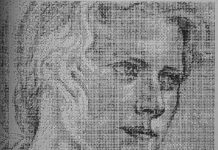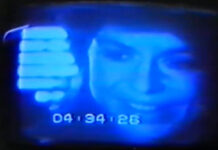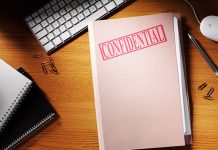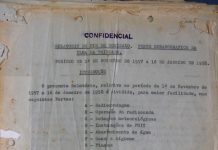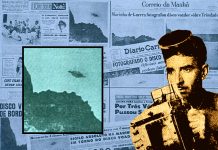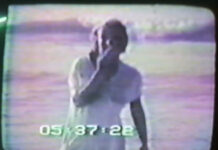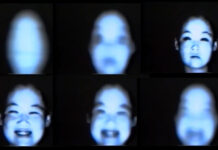Photographer swears that he heard from his uncle the secret to shake one of the all-time major Brazilian UFO cases
Translation by Richard W. Heiden
Note: The author of this article, Alexandre de Carvalho Borges, acknowledges that the only legitimate version of the Marcelo Ribeiro interview and of the complete article is what is published on the author’s Website, www.alemdaciencia.com. He has also approved this translation, for publication by Brent Raynes in his online magazine https://apmagazine.info/. Any publication on another site or in another medium is not recognized by the author as legitimate.
Unless otherwise specified, date references in the text (like people’s ages) are as of February 2011, when the article was posted in Portuguese.
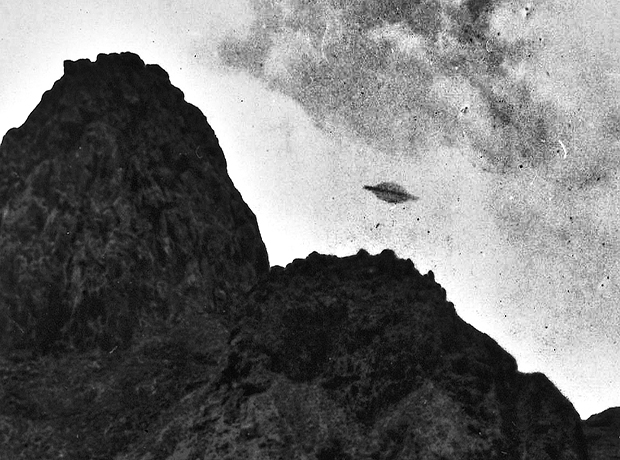
Possible fraud of the Trindade Island UFO case – Baraúna’s secret finally revealed?
More than half a century after the classic case of a sighting of a UFO over Trindade Island, recorded in photographs by Almiro Baraúna, a civilian photographer, debates continue about the authenticity of the photographs and the existence of eyewitnesses to the phenomenon.
The crucial question that has been asked lately is who are the witnesses who were aboard the training ship Almirante Saldanha and who witnessed the flying saucer on January 16, 1958.
According to the story, reprinted in books and articles on UFOs all over the world, there were 48 eyewitnesses to the UFO passing over the island. Who are these eyewitnesses?
According to contemporary newspapers and subsequent publications, they were military personnel and civilians. The controversy was rekindled in the 2010s, and critics questioned if there were really that many witnesses to the fateful episode and if the photos were indeed real.
In 2011, 53 years after the episode, a new version of the events was revealed in a way never seen before. For the first time, a new story about the Trindade Island case was revealed.
Baraúna kept a big secret and he died in 2000 without revealing it in public. One of the pillars of world ufology seems to be collapsing starting today. The classic Trindade Island case has been, until now, one of the best pieces of evidence that flying saucers exist.
The new version of the events claims: the Trindade Island flying saucer photographs were only a montage! Since 2002, this author has been more deeply involved with the Trindade Island case, and the end result is both unexpected and shocking. There is no way not to be surprised by the facts revealed here.
According to this new version of the events, the photos were just an elaborate trick and Baraúna was a great practical joker who deceived the whole of world ufology.
This conclusion could not have been fully reached without a thunderous statement by a key witness to the whole controversy. His name is Marcelo Ribeiro, 69, a professional photographer and nephew of Almiro Baraúna. Marcelo is an award-winning photographer who has worked in Brazil, Europe, and Africa.
Ribeiro has traveled to 72 countries, and when he was photographing in West Africa, he captured with his lens an old woman with a child walking through the Sahara Desert. He considers this picture to be one of the most important in his life, and it earned him an award from Nikon.
Ribeiro would be the only one in on the secret, who is still alive. After keeping it secret for so long, only now did he decide to reveal it publicly, telling the whole truth – according to him – about the Trindade Island case, and assures, “It was all a big joke, a mockery by Baraúna!”
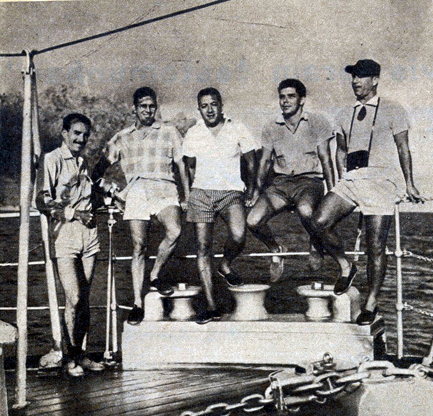
In the early years of this author’s investigations, in 2003, in search of relatives and friends of Baraúna, he was already aware that Baraúna had a nephew who was a photographer, but for some reason of fate, he did not contact him then.
With the eventual resumption of investigations in 2011, he is finally able to interview him by phone. Marcelo Ribeiro relates, without evasions or misgivings, how the whole episode developed and how it was no more than a big joke by Baraúna.
In this enlightening interview, we will learn the reasons, according to the interviewee, that led Baraúna to never confess his photomontage. The story of how it all happened will now be revealed.
UFO researchers from around the world have wondered about the authenticity of the photographs. According to Marcelo, the truth about them is very clear: the photographs were just a trick, a montage created by Baraúna in his own laboratory. That is one of the conclusions that we could reach after years of research on the case.
Baraúna was a professional photographer and was on Trindade Island as a member of Icaraí Spearfishing Club. The other four members of the club who were also on the island were: Amilar Vieira Filho (“Filho” is Portuguese for “son” or “junior”), José Teobaldo Viegas, Mauro Santos Andrade, and Aluizio Fonseca Araújo, all deceased. Baraúna became known as the main character of the whole episode.
If it were not because of his photographs, this UFO episode would have become forgotten in time, as were other sightings of UFOs from ships in those days, which left no photographic records.
Baraúna was a skilled photographer, pioneer in underwater photography, and author of the first underwater photographic report published in Brazil. He had achieved mastery in photographic manipulations to amuse or deceive people.
Throughout his life, he attracted the extremes of friendship and enmity with his work. He was a prankster, someone who enjoyed life, but he took photography very seriously and considered it his purpose in life. His professionalism, pioneering spirit, and competence, all above average, gave him respectability as a photographer.
He was the creator of the Barasub, a waterproof case for underwater photography that was successful at the time. His visit to the island was aimed at making underwater photographs for the Navy and also to write articles about the activities of the scientists there. The Trindade Island case became a classic in world ufology only because of Almiro Baraúna’s photographs.
Baraúna’s friends: divided opinions
A search for Baraúna’s photographer friends led this author to interview, in 2003, professional photographers Carlos Ruas and Zalmir Gonçalves. Ruas, who back in the 1950’s worked for the Diário Fluminense (Fluminense Daily), declared to the author that he believed in the veracity of the flying saucer photographs and that he had trust in the person of Baraúna as an honest man.
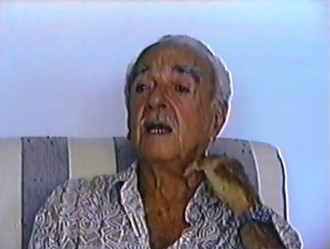
He emphasized that the previous photographic tricks realized by Baraúna, were just for fun. Gonçalves also endorsed the same arguments.
Baraúna and Ruas were part of a group of photographers from Niterói (in the state of Rio de Janeiro), in the 50’s, who were skilled in performing various photographic tricks, including montages to create flying saucers. Baraúna was considered one of the most skilled of the group.
At the time of the interview, neither Ruas nor Gonçalves knew the whole truth about the case. They did not know about the secret. As his nephew relates, the real enigma of how it all happened, was known by only three people of Baraúna’s confidence, two of them currently deceased. Marcelo is the last holder of Baraúna’s real secret, and it will now be revealed, unedited.
In 1958, the opinions of Baraúna’s friends were divided. Another colleague in the same group in Niterói, amateur photographer Joaquim Simões, deceased, claimed that the pictures were fake.
In Jornal do Brasil of February 23, 1958 (and in Diário Popular and other newspapers the next day), Simões charged: “He is really a great professional, expert in photomontages, able to perform miracles in a laboratory, but owner of a fantastic imagination and unbridled ambition to make his name as a photographer. But one should not play with the Navy and public opinion.” [1]
He continued in his criticism: “Nobody has better conditions than he has in Niterói, to make a flying saucer in a laboratory. Baraúna has a DeJur magnifier (6×9) and a Meopta (35 mm), both suitable for technical photographs, which require distortion of the image, tilting, and other techniques.” [1]
The news story further published that “Sr. Simões states that he never had the least friction with Baraúna. He wishes to remain his friend. He merely acknowledges that after this, Baraúna would never again feel comfortable with his peers, because with their knowing all his tricks, they never expected him to decide one day to fool so many people.” [1]
Baraúna’s response to Simões’s criticism was published in the newspaper O Globo on February 24, 1958:
“The accusation that Sr. Joaquim Simões, my ‘soi-disant’ colleague, now makes of me, that I now repeated the (confessed) montages of 1954, wanting to pass them off as real photos, has no merit. The photos taken aboard the training ship Almirante Saldanha are authentic. Technicians of unimpeachable integrity and competence, who examined the film, at the request of higher authorities of the Navy, so stated, as the newspapers reported. And above it all is the testimony of the people who were present at the events.” [2]
Based on the new version presented here, Joaquim Simões could be correct, despite never having heard any admission from Baraúna that he faked the photographs.
The inventory of tricks
Baraúna was an accomplished photographer, having already done photographic tricks before going to Trindade Island, and had great skill at performing new tricks.
In 1954 he wrote an article for the magazine O Mundo Ilustrado entitled “A Flying Saucer Was in My House… How You Can Make a Martian Ship, Or What Is the Truth or Untruth about Flying Saucers. Photographic Tricks That Can Be Used to Exploit and Amuse.” Baraúna presented photographs of how to make a flying saucer using two tokens from the old Rio de Janeiro-Niterói ferry company Frota Carioca, with accompanying text written by Vinícius Lima.
The photographic trick was not intended to mislead readers, as it clearly explained how to realize the montage. The end result of joining those two tokens brings to mind the very flying saucer photographed on Trindade Island, with a similar Saturn-like shape. [3]
Another of his photographic tricks—and this time he sold it as if it were real—is a treasure he had found in the state of Espírito Santo. There was no treasure. He set up a scene and sold pictures to the newspaper Tribuna da Imprensa, which bought them in the belief they were genuine. [1][4][5]
What many ufologists and UFO enthusiasts came to wonder about over the past few years was if the photographs of the flying saucer over Trindade Island were just another one of his tricks. Could Baraúna have managed to fool the Brazilian Navy? According to what his nephew says, Baraúna actually managed to fool the Navy.
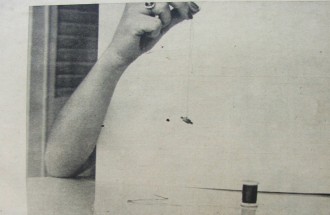
In 2002, this author contacted by e-mail the most famous UFO skeptic of that time, the American Philip Klass, to know his opinion about the case. He already considered the photographs a scam:
“I consider the photos to be a hoax for several reasons, including Barauna’s earlier creation of hoax UFO pix, plus the fact that none of the pix show longitudinal blurring due to UFO’s reported high speed and UFO image is not centered in photos.” [6] [Edited to change words in all-capitals to lower-case].
Investigations of the case continued. During a telephone conversation with one of the widows of Baraúna, Sra. Suraiha, in 2003, this author asked her who has the negatives, and she said that all of Baraúna’s material was with her, including the negatives, but she repeatedly refused to supply them for scientific analysis. Sra. Suraiha, now deceased, was one of the three people who knew Baraúna’s secret.
Today, based on new facts, we know that she did not provide the negatives — if she still had them — because she knew that the photographs were a montage and it was all just a big joke by Baraúna.
On the date of that interview, his first widow, who was also aware of the secret, was already deceased. So by that time, there were only two people who knew the real secret of how it all happened.
Was the flying saucer two spoons?
Although the previously-made criticisms cast doubt on the authenticity of the event, the last distrust in its credibility, so far, occurred in 2010.
On August 15 of that year, the TV show “Fantástico,” on Rede Globo, located and interviewed a friend of Baraúna’s family, publicist Emília Bittencourt. She said that she heard from Baraúna himself, 34 years after the event, the confirmation that his photos were just a montage.
“I had the opportunity to visit him 18 years ago, in Saquarema (state of Rio de Janeiro), and he told me how the story was made. He was on the Navy ship at Trindade Island and began to look to the sky and say, ‘Look there, an object, what is it, something flying.’ When he got home, he decided to make the joke. He grabbed two metal cooking spoons, put them together, and improvised a spaceship. He used the refrigerator in his house as the backdrop and illuminated it with a lamp. He precisely calculated the time and where the source of light came from. He was very precise, very smart. Then, starting with that, he managed to enlarge a photo of the flying saucer, which had as its background Trindade Island, and the two spoons that would be the spacecraft. That’s how he made the fraud of the photos”. [7][8][9]

According to Bittencourt, Baraúna was amused to remember the events and laughed a lot at the whole episode. The “Fantástico” program also broadcast the information that a niece of Baraúna’s had confirmed that the pictures were faked. Hours after the show aired, the photographer’s niece, who is now curator of his photographic estate, denied that she had confirmed the fraud.
She recounts that she had never heard her uncle’s confession to having manipulated the photographs, however, she remembered that Baraúna laughed at the people who think the whole episode was a fake. [10]
According to Marcelo, the niece was not one of the three people that knew about Baraúna’s secret. As we can see, not even all of his own family was aware of the secret. In any event, they all know now.
Who examined the negatives
The Navy ordered an analysis of the negatives at the time. One great failure by the senior officers, when they were still aboard the training ship Almirante Saldanha, was not having confiscated the negatives just after they had been exposed. The major error of the entire story is right there.
If Corvette Captain Carlos Alberto Ferreira Bacellar had confiscated the negatives immediately and taken them for analysis when the ship returned from the island, he would have seen, according this new version of the events, that there was nothing photographed in the skies.
The joke would have been discovered at that moment and the case would be no more important than many other episodes of UFO sightings. That was the great failure by the Navy.
Another major issue contributed to the military not finding anything: there was no photographic paper on board. Thus, it was impossible to print the negatives, which would clearly show if something had been picked up or not. This printing was only done by Baraúna himself, at his home.
The Navy itself has acknowledged these shortcomings, which it expressed in its final report. The publication, entitled “Report on the Observation of Unidentified Flying Objects Recorded on the Island of Trindade, in the Period from December 5, 1957, to January 16, 1958,” included these three topics:
“I. – No prints of the film were made at the time of its development.
II. – The ship’s captain did not take possession of the negatives, after development, in order to obtain prints later in the presence of witnesses.
III. – The prints and enlargements were made by the photographer in his own laboratory”. [11]
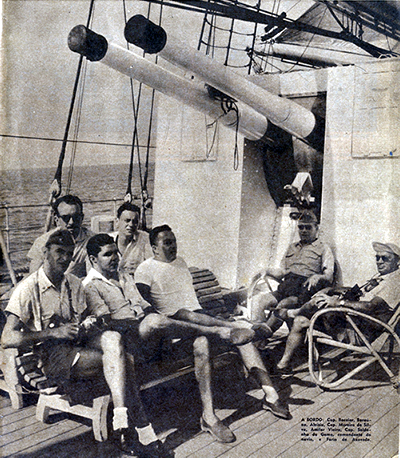
As no order was given to confiscate the negatives, Baraúna had them the whole time. The Almirante Saldanha training ship returned from the island and docked in Vitória, in the state of Espírito Santo. The ship would be docked for two days before heading back to Rio de Janeiro.
The five members of the Icaraí Spearfishing Club decided to leave the ship and take a bus to Niterói, Rio de Janeiro. Authorization to disembark was allowed only for civilians and denied to the military.
According to how Baraúna explained it, they decided to disembark at that moment and continue by bus, because two colleagues in the group were at the end of their vacation time and would miss some days of work if they had remained moored in Vitória. [5]
That excuse could be true, but he had something else in mind. Following the new version of events, he wanted to disembark then and get home as quickly as possible, taking the negatives with him.
The negatives remained in possession of Baraúna for eight days or more, from the moment he took the pictures on the ship. This was enough time for him to set up his montage work in his own laboratory, at home. Only after this did the Navy finally request them and have them analyzed.
Technicians in the Department of Hydrography and Navigation (DHN), of the Navy itself, and technicians of the Aerophotogrammetric Services of an aviation company, Cruzeiro do Sul (which no longer exists), conducted tests on the negatives. The result of this examination is extracted in the Navy’s final report:
“I. – The technician of the Navy’s Department of Hydrography and Navigation, after analyzing the negatives, declared they are natural;
II. – Technicians of the Aerophotogrammetric Services of Cruzeiro do Sul, after conducting microscopic examinations to verify the grain, analysis of signals, verification of luminosity, and details of contours, stated:
There was no sign of photomontage in the above-stated negatives, and all the evidence demonstrated that they were actually negatives of an object truly photographed.
The hypothesis of a photomontage devised after the sighting is excluded.
It is impossible to prove either the existence or the nonexistence of a prior photomontage; in any event, this is a technique requiring high precision and conditions favorable for its implementation”. [11]
As we can infer, apparently the Navy technicians made only a preliminary assessment, without delving into a deeper analysis.
More rigorous tests were conducted by the Aerophotogrammetric Services of Cruzeiro do Sul, which succeeded in excluding the possibility of a photomontage after the sighting, but not that of a photomontage created beforehand.
The report by Cruzeiro do Sul is still secret and the Navy never published it. In it, there should be detailed all the procedures undertaken in the analyses of the negatives. Even back then, the managing director of Cruzeiro do Sul, Hélio Meireles, now deceased, denied that his company had conducted tests on the negatives at the Navy’s request. [12]
We know today that either Meireles was unaware of what was happening in his own company, or he was hiding information, because the Navy’s report contained the recounting that such a laboratory performed the analysis.
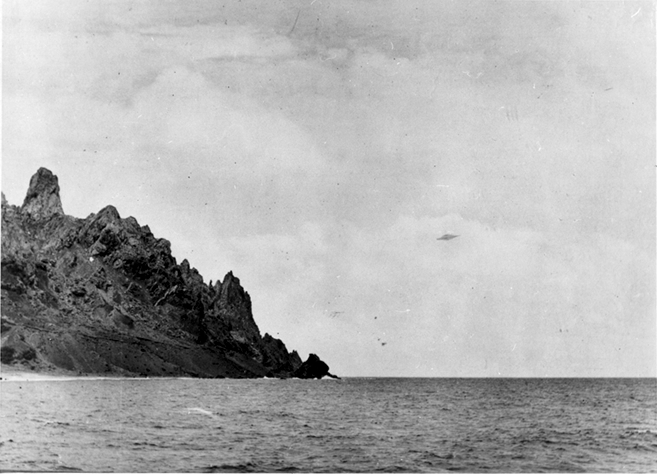
In 1983, 25 years after the event, Baraúna stated in an interview with astronomer and ufologist Josef Allen Hynek that the negatives had also been analyzed by a Kodak laboratory in Rochester, New York. [13]
Until then, in none of his previous interviews, had he made such a statement. Today, as his nephew relates, it is known that that was not true. In fact, that untruth could have already been discovered long ago.
The Navy’s own report makes no mention of Kodak having been engaged in such analyses. It just mentions that Aerophotogrammetric Services of Cruzeiro do Sul and the Navy itself analyzed the negatives.
In 1978, a civilian flying saucer research group, Ground Saucer Watch (GSW), now defunct, made an analysis of prints from the film and concluded that the photos were real. [14]
In fact, GSW analyzed what they had on hand, just the prints. The negatives were never sent overseas for any analysis. They always remained in Baraúna’s possession.
Other researchers outside Brazil also analyzed the prints. Some of them certified that the photographs were real, others put their authenticity in doubt or even concluded them to be false. We present below a summary table of some of the institutions that analyzed the photographs.
| Institution | Analyzed the negatives | Analyzed the prints |
| Brazilian Navy | Yes | Yes |
| Aerophotogrammetric Services Cruzeiro do Sul | Yes | Yes |
| Kodak | No | No |
| Ground Saucer Watch (GSW) | No | Yes |
Previously witnesses, now victims
One of the witnesses who reported seeing the UFO in the skies over the island was civilian, lawyer, and founder-president of the Icaraí Spearfishing Club, Amilar Vieira Filho. Vieira pioneered spearfishing in Niterói and was three times champion in this sport in South America.
At the time of the sighting he worked at the Banco do Brasil (Bank of Brazil) and later worked in a foreign trading company, opening his own office later. By 2008, aged 83, he was the last living member of the staff of Icaraí Spearfishing Club who was on the island, until he was murdered in an attempted robbery in Rio de Janeiro.
“I do not have the slightest interest in debating whether there was fraud or not. I’m telling you, that is my observation, that I saw the object and I will never deny it!” [15]
At the time of the sighting, he told the newspaper O Globo, in its issue of February 28, 1958, that what he saw “was an object initially gray in color, oval in shape, which passed over the island and then, acquiring a fluorescent type of light, disappeared in the distance, until the light source was extinguished just above the horizon.” [16]
When this author asked him about the possibility of Baraúna having manipulated the photographs, he considered the possibility:
“It might be. But it had the appearance of the object in the sky, that’s what I’m saying, because I observed the object. I’ll say this here once and for all. If he did anything to manipulate the film, I do not know, but he based it on the object in the sky. If he did a trick, it fit what was seen in the sky”. [15]
Today we know that not even his own friend, Vieira, knew Baraúna’s secret. Critics at the time, back in 1958, charged that there was a conspiracy between the five members of the club and that they had made up the whole story, pretending to have seen a flying saucer in the skies over the island.
We know that is not true, based in this new version of the facts. The reality is that none of the other four members of the Spearfishing Club knew Baraúna’s secret. They, too, were also fooled.
The interview: the revealing of Baraúna’s secret
We now present the interview with Baraúna’s nephew, Marcelo Ribeiro, who is also a photographer. In it, he assures that he is revealing, in detail, Baraúna’s secret, kept hidden for 53 years. The interview was done on January 27 and 30, 2011.
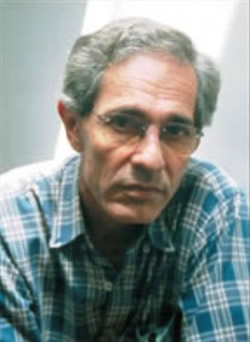
What is the truth about the pictures?
They are not true. Also because there is no flying saucer, is there? If there were, do you think that only he would be able to shoot it? He told me this entire story and made so much money with it at the time. He told several stories to other people. I even saw an interview on television [on the “Fantástico” TV show], that somebody else gave. Just last year one [an interview] came out.
They have a girl [Emília Bittencourt] who said he told her about it. It is nothing like that, it is all a lie. That isn’t the real story. In fact, people saw something there. There was something, a cloud formation, something. He was coming out of the water.
He was taking pictures underwater for the Navy, and when he was getting out [of the water], he had no more film in the camera. He had already used it all down there. When people saw that business, he thought it was nothing, but he was a reporter and reporters click first and look afterwards.
He had no film, but he acted as if he had about ten photos there, pressing and winding. And he ran to his cabin to grab some more film. When he returned, the thing was no longer there, the shape had already disappeared.
Q. So, he photographed nothing?
A. He did not photograph anything there. He photographed the sky. Later he made a montage in the laboratory. He had done other things such as the treasure for [the magazine] O Mundo Ilustrado, There was no treasure, it was an outright lie. He liked to play with that, he did not do it in bad faith. He liked to joke about this thing of people believing anything. Baraúna was a great joker and had a fantastic sense of humor.
He was a charming person in this sense, and very much a fun-loving guy, he fooled around a lot. There were tokens from the Frota Carioca, and I got to see him doing it once in his house. He hung the Frota Carioca token in the window against the night sky. He used to do these things, that I got tired of seeing it. So he did it, and as people began to get into it, he let it continue.
Q. So he pretended to be taking pictures?
A. Some people saw him there [on the ship] clicking and winding. People saw it, so they believed he had really done it. Who is going to say otherwise?
Q. I’m understanding that something really appeared in the sky, but he didn’t manage to shoot any pictures?
A. No, because he doesn’t have film.
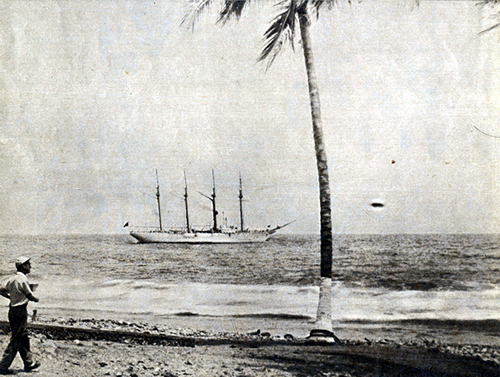
Q. But was there something in the sky? An object? A disk?
A. Of course! An object, no! There appeared a cloud formation, or — how should I know! — a meteorological balloon, something. It really appeared. The people saw something, yes.
Q. But he didn’t have more film?
A. When he got out of the water, he didn’t have more film.
Q. Baraúna claimed that he was on the deck, he was already top-side [at the time of the sighting].
A. When he left the water of course he was on the deck. When he got there the people were looking: “Look there! Look there!…” etc. And he saw. He saw that there was really something there. Then he simulated it there, because he knew that later he could simulate the rest. Baraúna was a very smart person. He didn’t want to miss the opportunity.
Q. Rolleiflex films at that time had 12 shots. Had he already used up all 12?
A. Yes. He had already used several rolls there, because he dived with two or three cameras. Each camera had film with twelve [shots]. But that time, he ran to the cabin, put in another film, and went back to try to do something, to see what he could get. That is normal for people to do.
Somebody like a photographer takes advantage of every opportunity. When he got home, news broke about a flying saucer sighting, so he said “Hey! I’m going to make some money with that, everybody is spotting flying saucers, I’m going to make a flying saucer.” And so he made good money.
Q. In the interview with Emília Bittencourt last year [2010] she said the flying saucer was two spoons, one on top of the other.
A. It had nothing to do with spoons. If you place a spoon, you will see it is not possible to do it. That is what he told her [Bittencourt], because he was a great joker, didn’t I tell you that? Even with people he knew. She is not a relative of his, she is a friend. Everybody kept pestering him, wanting to know what it was: “How did you do it?”
He used to say, “Well, that’s a lie, I didn’t really do it,” and so on. People got so curious. At the same time, he also seemed to be joking when he said it was a lie, can you understand that? He was a great joker. Baraúna was a character. If you put two spoons together, you cannot make it. I am a photographer and I know it is not possible.
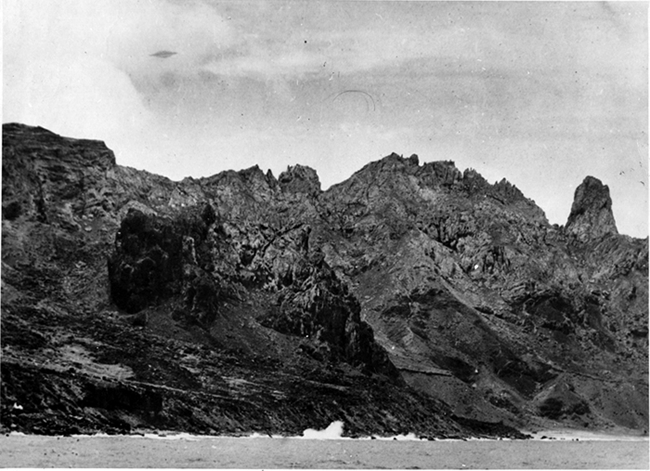
Q. So what should he have used in order to make the flying saucer?
A. He used a token from the old Frota Carioca.
Q. He had previously prepared a report with those tokens in the [magazine] O Mundo Ilustrado.
A. Yes. He knew he could do that with the tokens.
Q. So he just repeated the trick?
A. Yes. He was a great lab technician and did unbelievable things in the laboratory. He was fantastic. Everything that I know about photography, he taught it to me. He was a first-class black-and-white photographer. When he was a photographer and I was still a child in the family he was looked down upon.
Because [at that time] a photographer was someone who could not succeed at anything else. It was a second-class occupation, but he fascinated me, and I was still very young. He was married to my aunt. I was fascinated by his skill and he was a great human figure, he lived a good life and enjoyed it a lot.
Q. OK. Nevertheless, how was it possible [to get away with it]? Because the negatives were analyzed by Cruzeiro do Sul.
A. They analyzed the grain, and it was real. If you analyze the granularity, the grain is there, because he photographed the token against a dark sky. The image is real.
Q. So he prepared a double exposure? He took the token and inserted it into the landscape of the island?
A. Of course! And it is easy to do.
Q. And technical examinations would not detect it?
A. No, of course not. Let me tell you: one of my companions from the studio and travels is also a great black-and-white photographer. He won a prize from Asahi Pentax, in Japan, for a reproduction of a photo he had made with another camera. In order to participate in a contest by Nikon, Pentax, or Canon, you send them the negative and your entry had to be a photo made with the lens of a camera participating in the contest.
He had previously taken a beautiful photo using a Yashica. So he made a beautiful enlargement of that photo [on paper] and then took a picture of it with an Asahi Pentax. The photo was so well done that the grain [of the negative] of the Pentax camera is not going to show that it is a print, that reproduction is so good. You will only have the grain structure [of the negative] of the camera that you used.
Q. He reproduced the negative of the island on photographic paper and then took a picture with the token suspended in that image?
A. No. He made a double exposure. He took the photo of the saucer against the night sky, at his house in Niterói. After that he printed it together with the sky of the island. He photographed the token, which is the saucer, and combined it with the photo of the island. He combined the two. The quality of that depends on one’s ability to do it. If I try it, everybody would know it was me. I am not good at it. I am a good photographer, but not a skilled lab technician.
Q. So you mean that it was different from that Japanese contest you’ve mentioned, when the photographer took a picture of a printed photo?
A. Yes, this is different. [In the contest] he photographed a picture. He made a very high quality enlargement and photographed that enlarged [printed] photo.
Q. Can we say that the personnel of the Navy and of Cruzeiro do Sul were deluded?
A. I wouldn’t say that, because the truth is that you can’t tell. It is not that they were incompetent. Because you also have that you see what you want to see. The same way people [of the ship] believed they had seen a flying saucer, they [the technicians] believed Baraúna had photographed one.
This is how their minds worked while they were checking the negative. Their heads are going to function differently. This is not to say that they were incompetent or in bad faith. It is that they would never detect it from the grain structure, as it [the structure] was real.
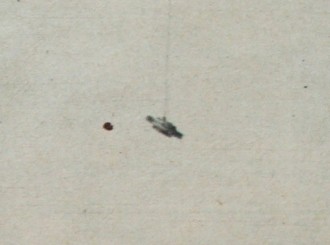
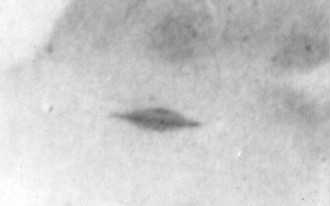
Q. Isn’t there another analysis that could detect the double exposure?
A. No. Not even if it was American, German, etc. Of course not. Just like the Japanese [contest] could not detect it. The negative he sent [to the Navy] is the negative of the montage. Therefore, the flying saucer and the island grains are the same, it is the same grain because they are in the same negative. He was so skilled that in the image he reproduced to submit the negative, you do not spot the montage he made there where he was photographing [in his lab].
That is where he could have made a mistake that would show in the negative. However, he was so good at it that the technicians could not find anything. And another thing: the sky that day [on Trindade Island] was not blue, it was cloudy, a bit grayish, and that made his work even easier. If the sky were blue, it would be more difficult to make the montage.
Q. After Baraúna developed the negatives, still on board, Captain Bacellar took them while still wet and said he saw the object in them. Baraúna said the sailors also looked through a magnifying glass and said the object that was seen in the sky corresponded to what was in the negative. How could Baraúna fool them about that?
A. You have to bear in mind that it was the 1950’s. There was nothing there. Not everyone knows how to look at a negative. Everybody looks at the negative, and then what? Do you know how to look at a negative if you are not a photographer or a lab technician? There are even some photographers who cannot do it. Only a laboratory technician knows how to look at a negative [with a technical eye].
When someone says, “It’s here, do you see it?” [others will say]: “Yes, I see it.” Anyone will say they see it. I doubt someone would say: “I can’t see anything, you’re lying.” It was a decade when everyone believed in these things, they appeared all the time. You have thousands of stories of those things appearing. If you show it, people will say they see, because the environment would lead you to say so.
Q. And did the negatives stay with O Cruzeiro?
A. No, no one saw those negatives again. The negatives remained with him and he did not leave them with anyone. He used to say he would leave them with me, but he died suddenly. I think he was procrastinating…
Q. Wouldn’t they be with his niece?
A. No, not with the niece. He did not have them in the archives she has. He left those archives with his wife, and after she passed away, his niece went there and took them. They always said they would leave them with me, because I was a photographer and his nephew.
Q. So, he destroyed the negatives?
A. He destroyed them, they are not with her. He didn’t leave the negatives with anybody, he kept them himself. I saw those negatives in his house, with him. And he used to say: “Later I am going to leave it all to you in writing and I am going to leave as an inheritance for you, and after that you tell the story.”
Q. Did he tell you to reveal the whole story?
A. Yes, I used to say to him, “Damn, Baraúna, tell it all now, you’re going to die laughing.” And he would reply to me, “No. I would be discredited, the guys will get mad at me.”
Q. So Baraúna told you that you could tell everything after his death?
A. He told me the truth for several reasons. First, he knew I didn’t believe in any flying saucer story at all. [I used to tell him]: “Baraúna, there is no flying saucer. What was that? It was a cloud with an unusual shape. Anyway, tell me what that was because these things do not exist.” Second, I was a photographer as well. I was a successor to him, as he had no children. I was somewhat like a son.
When I started to get really interested in photography, I would arrive at his house at nine at night and leave at six or seven in the morning. He teaching me and the two of us practicing in the lab. We had a close relationship and he was proud of that. When I won the Nikon prize, he was amazed and said, “Man, so what I taught you was worth it. You got an award from Nikon!” We had a beautiful relationship.
Q. If an analysis of the negatives was done today, would it detect the hoax?
A. No. Technology improved some things, but the analysis you would do is the same. It doesn’t mean that you could count on some modern equipment. And I do not call it a hoax. I call it a big joke, because it did not really exist. A hoax to me is when you try to falsify something that really exists. Flying saucers do not exist. We are isolated here.
There is no possibility of something coming from another planet, they are billions and billions of light-years [away]. Otherwise, physicists would all believe in the possibility of a flying saucer. You take Marcelo Gleiser, one of the greatest physicists in the world, and ask him about it, and he starts laughing. He doesn’t believe in God, is he going to believe in flying saucers?
Q. The prints have been analyzed and people say the clouds look different in the images, as if they had dramatically moved. However, Baraúna said at the time of the sighting that the object appeared for only a few seconds.
A. Maybe people can detect something by looking at the prints. But what they did before was analyze the grain structure. This analysis is different, it is something else: people are comparing the cloud position. But it will not prove anything either. They can only say it looks like this or that. They can say they believe it is not real for this or that reason. But it is really not.

Q. And now they discovered something else too. It seems Baraúna took the saucer from the first photo and inverted it 180º in another one.
A. Because you could also turn the tokens upside down. There was a little hole in the middle through which he passed a black thread in front of the black-sky background. You do not see the black thread. You only see the token isolated in space, because the background is black. He also played light on it and polished the token to make it shine. I saw him doing that at night at his home, in the Paraíba Building.
Q. Did you see him making specifically the [Trindade] photo?
A. Not exactly that one. I saw another one he made for another story, another joke.
Q. Baraúna himself also said the negatives had been analyzed by Kodak, in Rochester, in the United States.
A. No. That didn’t happen. It was only the Navy and the Aerophotogrammetric Services of Cruzeiro do Sul, which was a very good service. They had a very good lab and very good technicians. Baraúna had worked there.
Q. He had worked there? So he knew about their capability?
A. Everybody there knew him. He knew those technicians would never detect it [the hoax], because it is not possible to detect. That is not the way.
Q. You said that some of the military saw the saucer, but how about Baraúna himself? Did he see it or not?
A. Yes, he could see it. There was something there, some design, a formation, a cloud, something. But as he did not have any more film, he ran to get some. Because, if it was not possible to photograph, he knew what to do [later]. He wanted to sell them to newspapers and magazines, as he did. The newspaper Correio da Manhã bought them. Baraúna bought a lot of equipment, very expensive stuff. All because of those pictures.
Q. Some newspaper clippings said he could even buy an apartment.
A. This is true. He bought an apartment at the corner of [Coronel] Moreira Cézar Street and Canal Street, in Niterói.
Q. Did he also equip his lab with that money?
A. Yes. And he bought a motorbike at that time.
Q. So it was a lot of money?
A. Sold all over the world.
Q. The value I got here is that it would be 40,000 cruzeiros [Note: Baraúna said it was 60,000 cruzeiros].
A. I don’t remember. The amount should be around that. It was a lot of money, today it would be over 400,000 [reais] [$240,000 US].
Q. Who paid that, was it O Cruzeiro magazine?
A. No. He first sold it to the newspaper Correio da Manhã. Then O Cruzeiro was interested in making a report, so he sold it to O Cruzeiro, and then to European and American magazines. You didn’t have internet, you didn’t have cable TV, you didn’t have anything, it was another story.
So, it was published here, and correspondents would see it, and then call others saying, “Look, we have some material here.” So the other side would decide whether to buy it or not. In total he made around that amount. I do not know, do not remember anymore. Really, he bought an apartment, a motorbike, a Hasselblad [camera], a Leica [camera]. All first-class and very expensive equipment.
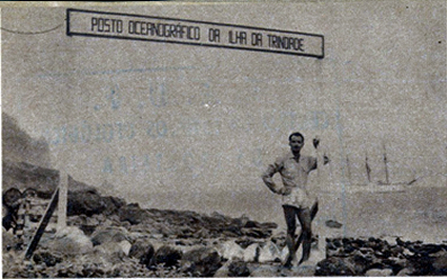
Q. In 2003 I called Amilar Vieira, Baraúna’s friend. He said he saw the saucer and would die knowing that. People could say whatever they wanted, but he had seen it.
A. He saw what he saw. People see whatever they want. I say that because I am a photographer by choice, but my educational background is psychology. I have an idea about how people’s minds work. For over twenty years I was married to the mother of my children, a psychoanalyst from the UERJ [University of the State of Rio de Janeiro], and I lived my whole life with talk of Freud.
So I know that people see what they want to see. Especially at that time, when people did not know what was possible or not. No rockets had gone to the Moon and the knowledge about the Universe was much poorer than it is today.
Q. Looking at it psychologically, then what must have happened, on board, was mass hysteria by the military?
A. Of course. Everybody was fascinated, everybody saw a flying saucer.
Q. Is there any possibility that he had prepared the photographs beforehand?
A. No, not beforehand. He had already made a report that was not discredited. People believed it was true, as they also believed the story about the treasure on the beach. He knew he could joke. People play with others’ imaginations.
Q. So, he arrived at the island without knowing anything, and after he saw the thing appear in the sky, he decided to prepare the joke?
A. Of course. He used to say, “Damn, it could mean some money.” Baraúna was an intelligent guy, quick to realize that “if everyone believes it, I’m going to make money.” Baraúna was too much. But he did not do that in bad faith. It is important to make that very clear. He did it as a big joke, because that was the way he was. He liked to make that kind of joke.
Q. And the Navy bought the story.
A. They did, because they take everything very seriously. They have that kind of strict thinking that led everyone to believe. When the Captain said he saw it do you think anybody would contradict him?
That’s how it works, especially at a time when people really believed it was possible and that it existed, everything came together to make it seem real. Such were the circumstances and the time. Discoveries about the Universe were still being made. Do you see how much science has discovered from that time until now? It’s absurd.
Q. What is most surprising is that even years and years later he never revealed anything. He gave interviews, twenty years afterward and thirty years afterward.
A. I have one of his interviews that I recorded. And he talks about it seriously [laughing]. Actually, as people get older, I think it was more and more difficult to deny anything. I really think he had a bit of that concern: “Hey, I’d be discredited.” Also because he made a lot of money with that.
Q. People would see it in a different way, they would call him a charlatan.
A. Right, a charlatan. I think there is also that side to the story. He said: “If people believed, then let it be.”
Q. Did his widow, Suraiha, know it was all a big joke?
A. Which one? He had two. Suraiha was the second wife, the one who died later. He lived with both the whole time. One of them was my aunt [Adoléa Ribeiro Baraúna], my father’s sister. He only met Suraiha many years later. Suraiha was a very good friend, I liked her a lot too, I got along very well with both of them.
When my aunt died, I too was left a widower from my first marriage, back then, in an accident. When my aunt died, he hugged me and said: “My son, and now, what is going to become of me?” I said, “Hey, guy, you are better than I am, you have two, one died, one was left. I don’t have anyone, I had only one” (laughter). Suraiha knew it and my aunt knew it too.
Q. Did every family member know [about the hoax]?
A. No. Only Suraiha, my aunt, and I.
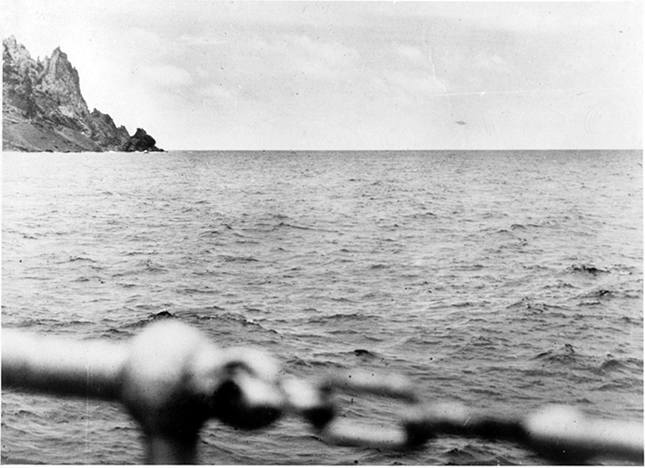
Q. What about his niece?
A. No, she didn’t know. Not the real truth. To each relative or person who asked, he would tell a different story. At the same time, he was always making fun of everyone. No one knew which story was true. He would tell another story each time, so each person got [a different] one. She told her [Emília] this story about the spoon, and so it went.
Q. And there is no possibility of it being a cooking spoon?
A. No. Of course not. Pick up a spoon and look, you will see it doesn’t work.
Q. And if he cut off the handle of the spoon?
A. No way. The design of a spoon is not the same [as in the photos]. It does not exist.
Q. How about the members of the Spearfishing Club? Did they know it was a montage?
A. No. Baraúna was not stupid. He could not let anyone know, otherwise he would be discredited. There was also the issue of the Navy. The fact that the Navy was involved could even result in a jail sentence. Especially under an authoritarian regime that was even worse back then. The military was already preparing for the 1964 coup after the one in 1955. I also did not give much importance to the whole story. I joked with Baraúna, he screwed around, and he would laugh a lot.
Q. Wrapping up, I thank you, your statements were very enlightening.
A. It is all right. I just want you to put out the truth. It is not to say he was a charlatan or anything like that, because he was not. He was just a joker, a great one. He was not a charlatan, he was a serious guy. Few people treated photography as seriously as he did. He was a great photographer.
Trindade Island Case reduced to ashes?
The classic Trindade Island case occurred when modern ufology had just been born. Only eleven years had passed since Kenneth Arnold’s flight at Mount Rainier.
Ufology matured during the succeeding decades, and a review of this classic will help it refine the maturity of understanding the phenomenon – a phenomenon that sometimes eludes us by presenting itself as an enigma and a charade, other times presenting itself as threatening and insolent.
The possible revelation of Baraúna’s 53-year old secret (if it survives challenges) must be seen by ufology as a big lesson, especially when it comes to dealing with images and witness statements.
Now more than ever, it is imperative that all previous classics that were not yet reviewed be subject to a thorough analysis in order to produce what really matters: the truth, whatever it might be and no matter whom it might please or displease.
The possibility that Almiro Baraúna’s world-famous photographs could be just a montage would be a big blow to ufology. Ufologists must be more and more merciless and callous in their future research. This is what the Trindade Island case teaches us as a legacy for the future.
What remains of the ashes of the Trindade Island case? If we accept as real the testimony of the nephew, the only investigation, from here on, is knowing if a UFO really appeared in the skies at that moment or if it was all no more than mass hysteria with the sighting of something commonplace. As we saw in the interview, Marcelo Ribeiro, being skeptical of the existence of flying saucers, has his own view of the UFO subject that is certainly not the same as that of ufologists.
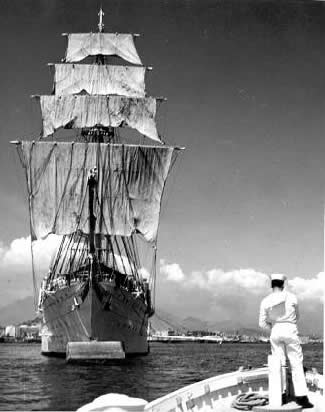
Did a UFO appear in the skies over the island and was Baraúna so unlucky as to have no film in his camera to take a photograph when it appeared? Or was it just an ordinary phenomenon in the sky turned into a big joke by the sailors, which led to mass hysteria on board? This latter hypothesis is not outlandish and one to dismiss. Future investigations will certainly uncover the truth about it as well.
Baraúna’s photographs might enter history as the best montage ever accomplished in UFO photography. It confirms the old truth that UFO pictures and films were never and will never be the ultimate proof of the existence of UFOs.
Had it not been for this alleged confession that it was all nothing but an excellent montage, those pictures would still be regarded as authentic for many more years.
It is also true that they would continue being put in question by many, but the suspicion would not be enough to dismiss them as fake. Wherever he might be, Baraúna must still be laughing about it a lot.
Summary of the facts
In order to condense in the clearest manner the impact of the revelation of Baraúna’s secret – according to his nephew Marcelo Ribeiro’s version – here is a summary of how it all happened: Baraúna was taking underwater photographs at Trindade Island, and when he came up to the deck of the ship, he saw people pointing and looking at the sky.
They were saying that a flying saucer was flying over the island. As he had used up all of his film underwater, he could not photograph the precise moment when the alleged object was flying in the sky. Therefore, he pretended to be taking pictures by framing the flying saucer in his lens.
In order to get something for real, he ran into his cabin to get new rolls of film. When he returned, the flying saucer had vanished. He had lost his opportunity. He then decided to take several pictures of just the island, showing the sky and the sea.
Later, at home, he would create a montage and put a flying saucer above the landscape. Corvette Captain Carlos Bacellar ordered Baraúna to develop his film while still on board. Baraúna developed some of his rolls and showed them to the captain.
Bacellar thought he could see the flying saucer in the negatives and showed them to the sailors, who agreed there was something in the picture.
Actually, because they lacked a skilled eye, they thought they had seen something on the negatives when they didn’t. Baraúna was lucky, because the Captain did not impound his negatives, and also because there was no photographic paper on the ship in order to be able to print the pictures and show clearly whether he had captured anything in his camera.
Baraúna took the negatives home and started to work on the photo montage in his lab. As he had not photographed any flying saucer, the pictures showed only the island, the sky, the sea, and parts of the ship.
He then used two tokens from the Frota Carioca company to make the flying saucer. The tokens had a Saturn-shaped look when one was put on top of the other. The tokens were then hung by a dark thread and placed against a dark background.
He made a double exposure with the scenery of the island and it was done! Now a flying saucer appears in the skies over the island. The picture was not out of focus or blurred, because Baraúna applied all of his expertise to it. He calculated light and shadow for the flying saucer. He realized that it was a great opportunity for him to collect excellent financial returns.
Moreover, he was a freelancer at that time, and wanted to take advantage of the opportunity to make himself known worldwide. He put his best into that masterpiece and kept secret about the montage. Days later when the Navy asked for his negatives, obviously he was not going to give them the ones he had made on the ship, as they did not show anything in the sky.
He turned over the negatives he had just prepared with the island and the tokens. Experts from the Navy and the Aerophotogrammetric Services of Cruzeiro do Sul analyzed the negatives and did not find any tricks.
The granularity or grain analysis did not detect the montage. They would never detect it, since the island’s grains were the same as the flying saucer’s. Now they were both in the same negative. Those pictures conquered the world and the rest is history.
References
[1] “Fotógrafo é especialista em discos: já fez dois.” Diário Popular, Rio de Janeiro, Feb. 24, 1958.
[2] “Também oficiais, entre outras pessoas, viram o disco voador.” O Globo, Rio de Janeiro, Feb. 24, 1958, p. 5.
[3] Vinícius Lima (text) and Almiro Baraúna (photos), “Um disco voador esteve em minha casa…” O Mundo Ilustrado, Rio de Janeiro, year II, no. 93, Nov. 10, 1954, pp. 38-39.
[4] “Marinha quer saber se ‘Disco-Baraúna’ é ‘furo’ ou chantagem.” Tribuna da Imprensa, Rio de Janeiro, Feb. 25, 1958, p. 1.
[5] PETIT, Marco Antonio. “Caso Trindade: novas revelações.” Conservatória, Rio de Janeiro, 2000. Videocassette (40 min), VHS/NTSC, sound, color.
[6] KLASS, Philip. Personal communication to the author, Aug. 25, 2002.
[7] “Aeronáutica divulga procedimentos em caso de aparição de discos voadores.” Episode of “Fantástico” TV program, Rio de Janeiro: Globo, Aug. 15, 2010. Available at <https://g1.globo.com/brasil/noticia/2010/08/familia-de-fotografo-revela-verdade-sobre-fotos-de-ovnis-em-trindade.html>.
[8] “Famosas fotos de disco voador são fraude, revela amiga do fotógrafo”. Fantástico online, Rio de Janeiro: Globo, Aug. 19, 2010. Available at <http://fantastico.globo.com/jornalismo/FANT/0,,MUL1614449-15605,00.html>.
[9] BORGES, Alexandre de Carvalho. “O OVNI da Ilha da Trindade seria duas colheres?” Além da Ciência, Aug. 17, 2010. Available at <https://www.alemdaciencia.com/o-ovni-da-ilha-da-trindade-seria-duas-colheres/>.
[10] BORGES, Alexandre de Carvalho. “Surge possível nova testemunha dos avistamentos de OVNIs na Ilha da Trindade.” Além da Ciência, Aug. 19, 2010. Available at <https://www.alemdaciencia.com/surge-possivel-nova-testemunha-dos-avistamentos-de-ovnis-na-ilha-da-trindade/>.
[11] BRANDÃO, José Geraldo. “Relatório sobre a observação de objetos aéreos não identificados, registrados na Ilha da Trindade, no período compreendido entre 5 de dezembro de 1957 e 16 de janeiro de 1958.” Navy of Brazil, Feb. 1958.
[12] “Alheios ao caso do disco voador.” O Globo, Rio de Janeiro, Feb. 25, 1958, p. 3.
[13] BARAÚNA, Almiro. “Entrevista com Almiro Baraúna.” Brasília: II Congresso Internacional de Ufologia, Apr. 19, 1983. Audio file (20 min.). Interview granted to J. Allen Hynek.
[14] HEWES, Hayden. “The Mystery Disk over Trindade Island.” UFO Report, vol. 7, no. 1, Feb. 1979, pp. 18-19 and 58.
[15] BORGES, Alexandre de Carvalho. “Interview with Amilar Vieira Filho: After 45 years a witness to a UFO at Trindade Island talks about criticism over the case.” Além da Ciência, Feb. 13, 2008. Available at <https://www.alemdaciencia.com/interview-with-amilar-vieira-filho-after-45-years-a-witness-to-a-ufo-at-trindade-island-talks-about-criticism-over-the-case/>.
[16] “Disco ou não, viu um objeto oval e luminoso nos céus de Trindade.” O Globo, Rio de Janeiro, Feb. 28, 1958, p. 4.


